On The Town with Chip Deffaa: At “New York, New York,” “Some Like It Hot,” and Seth Sikes & Nicholas King’s Nightclub Act
The resilient, uplifting spirit of New York, New York is particularly welcome at this moment. There’s a message of hope in this musical that I like very much. And they’ve got the strongest finale in town. Audience reaction to the show was mixed. But I sure hope this show can make it here!
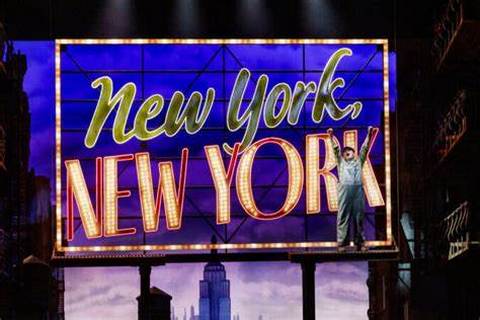
Jim Borstelmann in a scene from the new stage musical “New York, New York” at the St. James Theatre (Photo credit: Paul Kolnik)
[avatar user=”Chip DeFFaa” size=”96″ align=”left”] Chip DeFFaa, Editor-at-Large[/avatar]
In the last few weeks I feel like I’ve been stepping back in time—in a nice way. I’ve enjoyed seeing the new Broadway musicals New York, New York (set in 1946-47) and (with some definite reservations, which I’ll get to shortly,) Some Like It Hot (set in 1933). And although the current nightclub act of Seth Sikes and Nicolas King is set in the present, most of the Great America Songbook numbers that they sing were written long before they were born; and they put those numbers across with terrific razzle-dazzle showmanship—the kind you always hope to see in clubs but all-too-rarely do.
Let me tell you a little bit more about each of these shows (and more).
* * *
The late George Burns used to tell me that if a show has a really strong start and a really strong finish, you’ll forgive almost anything that happens in between. And I sure thought of George’s wise words as I watched Kander & Ebb’s New York, New York.
I was utterly charmed by the opening. I very quickly got caught up in this musical. I felt right away that this show has the look, feel, and sound of a winner. It’s a big, handsomely mounted production with 27 performers on the stage, plus a 20-piece orchestra. A score by John Kander and the late Fred Ebb, with additional lyrics by Lin-Manuel Miranda. In the early scenes, I was just happy as can be. I was thinking, “This is the best thing I’ve seen in a long time; it’s what New York City needs right now. I’m so glad I’m here.”
In addition, the production—directed and choreographed by Susan Stroman, in excellent form–ends as brilliantly as any show I’ve seen in years. I don’t want to say exactly how the show’s great final number (“New York, New York”) is presented—I don’t want to spoil anyone’s surprise—but I just loved it. BAM! The show projects such irresistible elan at the end.
But in between that wonderful start and that wonderful finish, there are times, alas, when the show feels a bit less than wonderful. When the book feels just a bit cluttered. When the well-intentioned writers (David Thompson and Sharon Washington) are having too many likeable characters make too many good points in too short a time, and as a result we’re only getting to know the characters in a superficial way. I might have preferred having fewer main characters, if I could have connected with them more deeply and felt their challenges more deeply. Or, if you wanted to keep every main character in the show, you could make the show longer in order to make greater character development possible. That could work great, too. For me, either of those choices might have made the show as a whole more satisfying. I like what the show is trying to say. But in the show’s present form, we don’t always get to know the characters too well, or feel for them as deeply as, ideally, we should.
I don’t want to overstate the show’s shortcomings, though, for me, the show’s many strengths certainly outweigh the weaknesses. There’s much to savor, put together by seasoned pros. I’d happily recommend this show to anyone. However, the shortcomings should be acknowledged. And you could hear the more muted audience response to some of the material. (I wish the show could have had a good, long out-of-town tryout to get it into more consistently strong shape.)
This is not a perfect show, like Kander & Ebb’s two masterworks, Chicago and Cabaret, are. (Those are two of the greatest musicals in the Broadway canon.) But it’s a good show, with lots to savor—and good new musicals are rare enough. I liked it a lot. I want to see it again. I want to get a cast album so I can become better acquainted with the score. And I hope the show is a big hit.
I like the tone. I like the spirit. My God, it’s good to have a new Kander and Ebb show. And Lin-Manuel Miranda’s lyrics work. I wondered if he would be a good fit for Kander, since Miranda’s Hamilton is stylistically so different from Kander & Ebb’s shows; but he is. And the score feels seamless.
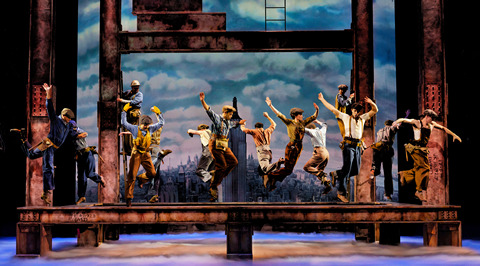
The cast of the new stage musical “New York, New York” at the St. James Theatre (Photo credit: Paul Kolnik)
Stroman’s choreography is first-rate. Give her some good dancers and a few umbrellas and she creates sheer magic in one number that’s as delightful as anything she’s ever done (which is saying plenty). It just might be my favorite bit of Stroman choreography yet in her long and distinguished career. (Although I’ll always love the unforgettable way she had everyone dancing and leaping and soaring in the library, in the 2000-2001 Broadway production of The Music Man that she directed and choreographed.)
The production values in New York, New York are all top-drawer—as fine as any show in town. And the show ought to garner awards. Ken Billington’s lighting is striking. Beowulf Boritt’s masterly settings have class, style, elegance, and serve the story perfectly. The show really looks great.
The sound design by Kai Harada, incidentally, is absolutely superb; this is exactly what a Broadway show should sound like—with each voice and each musical instrument coming through clearly, naturally, well-balanced. If the sound design is this perfect, you may well not even notice it; you simply experience the satisfaction of enjoying actors and musicians performing in the theater. You have the feel of the house, too, as well as the individual artists on stage. All good.
Colton Ryan really impressed me as the male lead in this show. I’ve seen him before (most recently in Girl from the North Country), but never fully realized what an engaging singer he could be until now. He’s got a lovely voice. And he’s emotionally expressive. I liked his work here very much.
And when I caught him, by chance, singing a number “live” from this musical on one of the morning TV shows, it only reinforced my sense that he’s just right for this show—a solid, utterly likeable leading man.
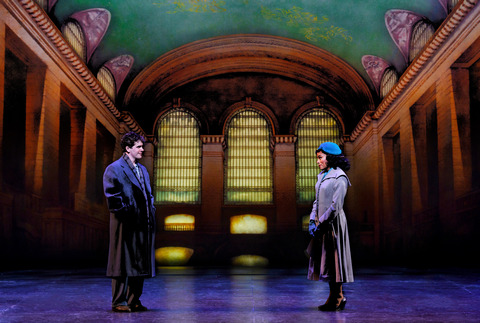
Colton Ryan and Anna Uzele in a scene from the new stage musical “New York, New York” at the St. James (Photo credit: Paul Kolnik)
I enjoyed the pride, sass and attitude that his costar, Anna Uzele, brought to the stage; but I found her singing a bit mannered for my tastes; I didn’t always buy her singing. However, in fairness I must add that she’s in an extremely difficult spot; when she sings such superb Kander & Ebb songs as “New Yok, New York” and “But the World Goes ‘Round,” she’s competing with our memories of Liza Minnelli, who introduced those songs in the film New York, New York. Liza sang those numbers with fierce conviction! Kander & Ebb, her all-time favorite songwriters, had written them for her. Liza simply “fit” Kander & Ebb’s songs as well an any singer could ever fit anyone’s songs. That’s a tough act for anyone to have to follow.
I was happy to see Emily Skinner and Clyde Alves make the most of their opportunities in this show. It’s always good to see these pros. I happily remember catching their Broadway debuts, a couple of decades ago. And I also liked seeing once again Jim Borstelmann—who’s enriched so many ensembles since he first danced in Jerome Robbins’ Broadway and Chicago a few decades ago.
There’s a resilient, uplifting spirit to New York, New York that feels particularly welcome at this moment in history, when New York in general—and Broadway in particular—is still struggling to fully recover from the pandemic. There’s a message of hope in this show I like very much. And they’ve got the strongest finale of any show in town right now. Can’t beat that. I liked this show. I hope they can make it here!
* * *
Boy! I can’t tell you how much I was looking forward to seeing Some Like It Hot. A new musical based on one of my favorite films, with a score by Marc Shaiman and Scott Wittman, whose work I certainly like. (They’ve given us Hairspray, Charlie and the Chocolate Factory, Catch Me If You Can, and Smash, to name a few of their fine credits.) And Casey Nicholaw (The Book of Mormon, Aladdin, etc.) would be directing and choreographing. Top talent.
I was excited from the first announcement that the show was in development. And when it was announced that Christian Borle would be heading the cast, I was even happier; he’s been a great favorite of mine for over 20 years. For me, this was one of the most highly anticipated shows of the season.
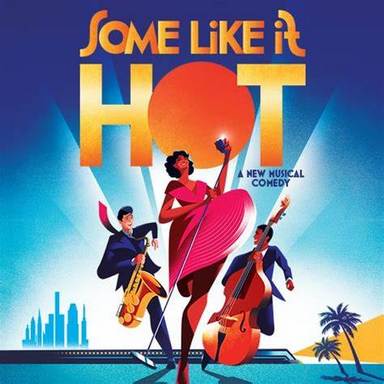
Show poster for “Some Like It Hot” at the Shubert Theatre
I wish I could be writing a rave review right now. This is another show I hope will be a hit. A lot of good people are connected to it. But I have to be honest. I didn’t have such a great time. Eventually, I hope to go back and see the show again and give it another chance. But all I can report right now is what I experienced at the performance I attended.
First impressions count for so much. And when the music started, it was so loud where I was sitting in the orchestra—the sound was so over-amplified—it was painfully uncomfortable for me. I felt like I was being assaulted, like I was being pushed back by a wall of over-amplified sound.
I’ve been to countless Broadway shows since I enjoyed seeing My Fair Lady in its original Broadway run. I’ve rarely ever been bothered by poor sound design. But as the first measures of music hit my ears, I almost wanted to leave the theater. I’ve sometimes brought ear plugs (Flent’s Ear Stopples) to loud rock concerts, to use if needed. I’ve never brought ear plugs to a Broadway theater or felt there might be a need for some. But on this particular occasion, I was wishing I’d brought my Flent’s Ear Stopples with me.
There were a lot of empty seats in front of me. Maybe if they’d been filled with people—with each body absorbing some of the sound—the music wouldn’t have been quite so loud where I sat. Maybe (as a friend suggested) I just happened to be in a particularly bad location, perhaps too close to an amplifier or something. And maybe my hearing is more sensitive than some people’s.
But all I can report is what I experienced, sitting where I sat at the performance that I attended. And the over-amplified production was pushing me away before it even really got started. I wrote in my notes, “Worst sound design I’ve ever experienced.” The only other show I’ve seen in years that was, for me, annoyingly over-amplified, was Funny Girl. (There, too, I often felt like I was listening to an amplification system more than individual voices.) The sound design at New York, New York was, by contrast, just perfect. The next time I buy tix for Some Like it Hot, I’ll sit way up in the balcony and see if it’s better there. The loudness got in the way of me being able to properly enjoy the show.
The late master guitarist Bucky Pizzarelli used to tell me that the advent of loud rock concerts led to louder concerts generally, with too many audio engineers, producers, and audience members coming to feel that music must be cranked up to higher levels in order to be exciting. He didn’t like that notion himself; he didn’t believe you made everything more exciting by raising the volume. But he saw that as a trend in some quarters—the needless upping of volume. And I think he had a point. There’s plenty joy in the score of Some Like It Hot. The music doesn’t need to over-amplified, nor does it benefit from that. I enjoyed the show’s catchy, upbeat title song the first time I heard it in a radio commercial for the show more than I did in the theater. I didn’t need it to be amped up more in the theater.
Some Life It Hot was, by and large, too loud for my own personal tastes. But there were some good actors on that stage, nonetheless, and I want to acknowledge them. Star Christian Borle happened to be out at the performance I attended. And although I was sorry to have missed Borle, I was thoroughly charmed by his understudy, K.J. Hippensteel. He was an unexpected delight, utterly winning. I’m very glad that—by total chance—I got to see Hippensteel’s very likeable performance. I hope to see more of him on stage in the future. A very agreeable performer.
And seasoned pro Casey Nicholaw, who directed and choreographed Some Like It Hot with flair, went on in the role of the gangster Spats at the performance I attended. Nicholaw started out as a performer but gave up performing years ago to focus on directing and choreographing. I thought it was a great treat to see him onstage once again. And he sure did seem to be having fun up there. I admire him for stepping into the role. I’m glad I chanced to catch him.
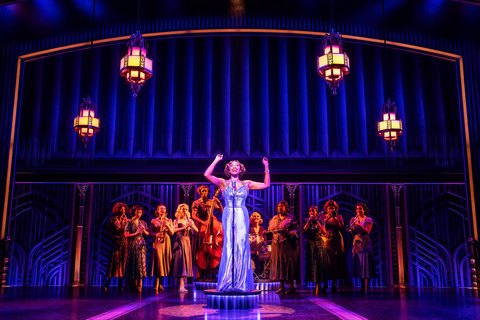
Adrianna Hicks and the company of “Some Like It Hot” at the Shubert Theatre (Photo credit: Matthew Murphy)
J. Harrison Ghee, Adrianna Hicks, NaTasha Yvette Williams all impressed. Such a likeable cast. And I appreciated the look of the whole show—the scenic design by Scott Pask, the costumes by Gregg Barnes. The book by Matthew López and Amber Ruffin has contemporary twists that work. (Although I do wish a way could have been found to have preserved verbatim some of Billy Wilder’s wonderfully well-turned dialogue from the movie; some perfect lines deserve to be heard again.)
I was surprised, though, that Wilder, who wrote and directed the original movie that inspired this production, is not credited in the program. He certainly deserves to have his name mentioned on the title page of the Playbill; he should also get a bio. He created the original characters and storyline; his genius deserves recognition. (The Broadway musical New York, New York appropriately credits Earl M. Rauch as the author of the original movie.)
This isn’t the first time someone’s tried to turn Wilder’s classic film into a Broadway musical. In 1972, I went to see the first stage-musical adaptation of the film Some Like It Hot, called Sugar. I was disappointed. Despite the involvement of such great artists as Robert Morse (one of my all-time favorite Broadway personalities) and Jule Styne (one of my all-time favorite Broadway composers), the show was highly uneven; it failed to capture the unique charm of the film. I was still glad I saw that musical, of course; it had some bright moments. (And I very much enjoyed Steve Condos in a supporting role as the tap-dancing gangster.) But it wasn’t what it could have—and should have–been.
I’m glad a new attempt has been made to musicalize the movie now. And the current script, while not as funny as Wilder’s, has an of-the-moment sensibility that appeals. I want to see this musical again some time, both to see Borle, whose work I always relish, and to see if the sound is better in another seat, in another part of the house. I’m sure I’d enjoy it a little more if I didn’t feel oppressed by the sound design. I’ll buy some tix in the balcony next time.
* * *
I’d been hearing such good reports about the duo act that Seth Sikes and Nicolas King have been touring with over the past six months, I was eager to make a reservation when I heard they were coming to 54 Below. Health problems prevented me from getting there in person. But the performance was livestreamed. So I watched it at home. This is the first time I’ve ever written about a livestreamed show. However, they sound so good together, I want to write a brief report now. And hopefully I can write in more detail the next time I’m able to see them “live.” (They’re scheduled to return to 54 Below in October.) But this is such an unusually satisfying pairing of performers, I want to tell you a little about them without delay.
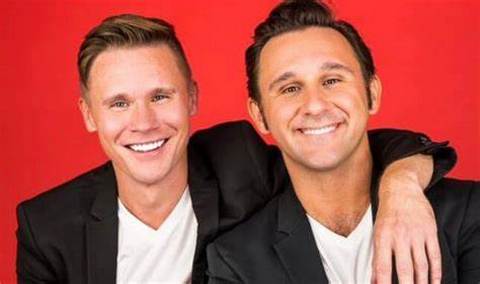
Seth Sikes and Nicolas King
Of course I’ve long known how great Seth Sikes is. He impressed me as an unknown at the very start of his career. He’s acted on stage for me and has recorded for me. Long before critics began raving about him—and long before he won any awards or became a top draw in the clubs—he struck me as being as fine a singer as anyone his age in NYC.
He’s such a strong performer on his own, I couldn’t understand why he’d want to try a duo act. And I wasn’t really familiar with Nicolas King’s work. Oh, I’d seen King in a few Broadway shows when he was a kid, about 20 years ago. (I enjoyed him most in the play A Thousand Clowns; that play really spoke to me.) But that was so long ago and he was so very young then, I had no idea what he was like now. If I’d seen him perform anywhere in the intervening years, I did not recall it.
But wow! Sikes and King sang together as if they’d been a duo all of their lives. (They’ve actually known each other less than a year.) Their voices—shimmering with life—complemented one another well as they darted and weaved and soared through numbers. They sang famed duets done by Judy Garland and Ethel Merman, and by Garland and Streisand. Duets that fit them so well, it seemed liked they’d been born to do them. And I got an extra kick at the way they carried off Johnny Mercer’s terrific “Two of a Kind,” with lots of extra verses. Just memorizing that intricate number—much less pulling it off well– takes lots of time! (And in this case I’m speaking from experience—because many years ago I actually rehearsed a very young Seth Sikes and Jon Peterson on that very number and even recorded them; I still have the chart, marked “Seth” and “Jon.”)
Sikes & King make a good duet team. (If I had known how good they were together, I’d have invited both to record.) They kidded one another in a cute way. They brought in the masterly Billy Stritch—who’s a completely satisfying act just by himself—to turn a couple of numbers into trios. They were endearing, they were exuberant, and they were musical. Sikes, who can do most anything well, wisely changed the tone at just the right moment, to show his vulnerable side on a reflective solo number, “Who Can I Turn To?”
I wish I could have been there in person. (Hopefully, when they return in October, I’ll go see them in person; maybe I’ll see you there.) The glittering audience included such notables as Randy Rainbow, Karen Mason, Lee Roy Reams, Michelle Lee. It was such a good night; the kind of night that helps restore your belief in NYC.






Leave a comment